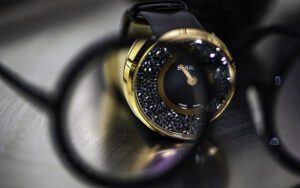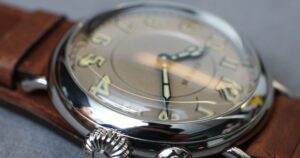You may find your next collector’s piece at a yard sale, a flea market, or even tucked away in a box in your parents’ attic. You might also choose to buy it brand new from the manufacturer.
Either way, every timepiece needs care and maintenance to function at its best. That can include regular cleaning and polishing, a battery change, or even full-on restoration. And while it’s essential to have an excellent watch repair shop on speed dial, our trained technicians here at Times Ticking suggest some of these things you can do on your own, provided you have the right tools.

One important note: Watch tools can get pricey, but it’s worth every extra penny to buy high-quality ones. You don’t have to get the top-of-the-line products, but it’s a good idea to stay with solid specialty tool manufacturers like Witschi, Bergeon, Horotec, and Elma.
Table of Contents
ToggleLoupe
Your watch may have anywhere from a few to more than a hundred tiny moving parts. To do precision work on each piece, watchmakers use a loupe. Unlike a magnifying glass, a loupe has no handle. Usually, technicians will attach the loupe to an elastic headband to allow hands-free work, but companies also make several handheld versions if you like to carry one with you.
As a collector, you’ll want to have at least one or two loupes in your possession to do repairs and to check for damages before you buy. While your eyes may miss a tiny scratch in the case, your loupe won’t. Loupes come in various magnification sizes, but 10x is standard for watch repair. With higher magnification, you’ll see increased distortion around the edges of the focal point, which can get annoying.
Unless you’re checking for tiny gemstone imperfections, a 10x triplet loupe will do fine. The triplet refers to the number of lenses in the loupe. Professionals prefer the three-lens combination because it offers a sharper focus for the entire field of vision and more defined colors.
Case Back Opener
Watches generally have three case backs: Screw-on, snap-on, and attached with tiny screws. Each design requires a different tool.
Your screw-on case back will have small notches around the edges specifically designed for a pocket wrench tool square. After fitting the wrench’s adjustable prongs snugly into the notches, turn the device counterclockwise and unscrew the back. A rubber friction ball also works well on a screw-on case back. Holding the watch face down in your hand, press the ball against the back and turn. The friction of the ball will give you the necessary leverage to turn the backing.
Snap-on cases usually have a slight indent or notch somewhere on the case under the backing. Press the blade into the indentation using a watch back knife and twist slightly until the back pops up. Once the backing’s loose, you can remove it with your fingers.
Finally, case backs attached with tiny screws need only a small screwdriver to detach them. Go figure. But this leads us to our next set of implements that you can’t live without – screwdrivers.
Screw Driver Set
If you have ever changed the batteries in a small electronic device, you probably already own these. They look like metal mechanical pencils with permanent or removable screw tips. Granted, if you bought your screwdrivers on the cheap, you might want to consider upgrading for work on your watch. Low-quality screw tips tend to wear out quickly and often break with too much pressure. The end could scratch your case back or damage your movement if that happens.
Your best option is to get a complete set because watch screws come in different sizes and styles, depending on whether they’re holding the movement together, attaching your watch back to the case, or holding your bracelet links in place. You don’t want to sit down to work only to discover you’re missing the correct screwdriver. Trust me, it’s frustrating.
Spring Bar Device
As with the case back tools, you have a few designs to choose from for removing and reattaching your spring bars. A typical spring bar tool will look a lot like a small screwdriver, with a pointed end for compressing spring bars with drilled-through lug holes and a fork end for removing spring bars when the lug holes are on the inside.
Another type of spring bar tool looks like a pair of tweezers with two fork tips. This device grabs the spring bar by both ends and pinches it together to lift the bracelet away from the case. Spring bar pliers work similarly but have additional features like reversible tips for different size fork ends and the ability to bi-angle the ends up to 45 degrees for a better grip.
One important thing to remember is that standard spring bar tools don’t always work with every watch. For example, Rolex and Omega watches use spring bars with different specifications, so some manufacturers make tools uniquely designed for those brands.
Items for Cleaning and Care
Watches are pieces of fine jewelry that quickly accumulate dirt, grime, grease, and oils, so it’s important to always have appropriate cleaning materials on hand. Appropriate is the key word here. You wouldn’t clean a 1969 Chevy Camaro with an old rag and dishwasher soap, so why would you reach for ordinary cleaning solutions for your prized timepiece?
Be sure to find great cleaning formulas that don’t include ammonia or other harsh chemicals that can damage your watch metal or crystal. In addition, using a microfiber cloth and a fine-bristled brush will give your timepiece a thorough clean while protecting it from micro-abrasions. Try to wear finger cots or soft cotton gloves when handling the watch and bracelet to avoid leaving oils from your hands.
Even with the right tools, things can still go wrong. If that happens, or if you would just rather have a professional handle your $5,000 Grand Seiko watch repair from the start, give us a call at (801) 991-1097.




